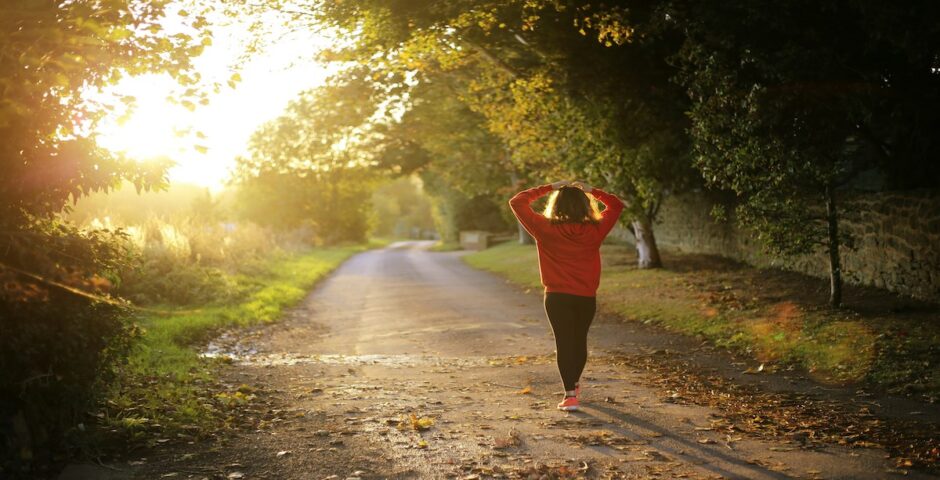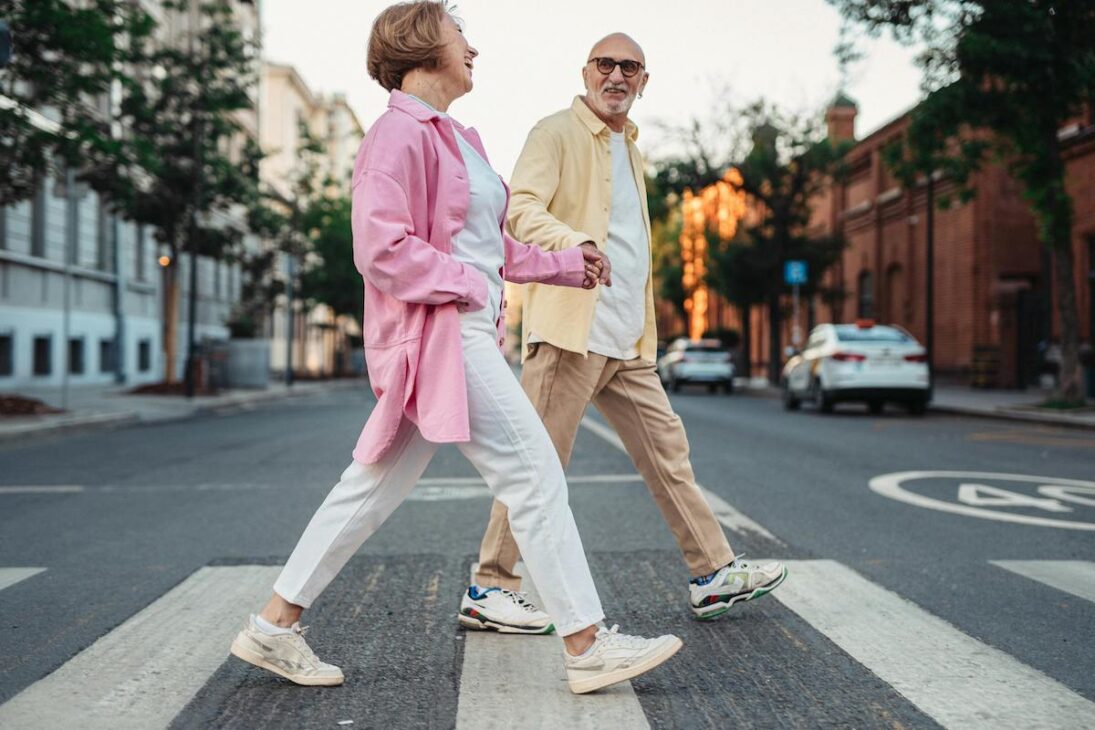
Walking For Exercise: 13 Unexpected Benefits
Walking for exercise is a simple and effective way to improve physical and mental health. It’s a low-impact activity to easily incorporate into your daily routine. In this Moodment blog, we’ll explore 13 unexpected benefits of walking for exercise that you may not have considered before.
1. Walking boosts your mood and fights anxiety

Did you know that going for a walk could be one of the most uplifting parts of your day? It’s true! Walking for exercise isn’t just about physical health; it plays a huge role in improving your mental state too. In fact, not everyone has to be a runner — walking for exercise counts too!
When you walk, your body releases endorphins, those natural mood lifters, helping to decrease stress levels and combat anxiety. It’s a fantastic, natural way to give yourself a mental health boost.
Whether you’re feeling a bit down or wrestling with anxious thoughts, slipping on your walking shoes and stepping out can offer you a much-needed sense of relief and happiness. Walking is a simple, yet powerful tool in maintaining your mental wellness.
2. The more steps you take, the better quality of sleep

Engaging in walking for exercise significantly enhances the quality of your nightly rest. It’s a gentle yet effective way to encourage your body into a deeper state of relaxation before bedtime.
Walking boosts the production of sleep-regulating hormones, helping you to establish a more consistent sleep pattern. This means not only can you enjoy the luxury of falling asleep more swiftly, but you’re also more likely to enjoy uninterrupted, quality sleep throughout the night.
Integrating walking into your daily life could be the key to feeling refreshed and rejuvenated every morning.
3. Walking for exercise helps the natural transition into menopause

Walking for exercise offers a unique, gentle approach to managing the symptoms associated with the transition into menopause. This straightforward activity promotes hormonal balance, potentially reducing the frequency and intensity of hot flashes and stabilizing mood swings.
By engaging in regular walks, you are helping your body navigate through premenopause and perimenopause. It’s a natural way to support your body’s adjustments during this significant phase, enhancing your overall well-being and comfort.
4. Boosting energy is easy to do when walking for exercise

It might seem counterintuitive, but lacing up your sneakers for a walk can be the energy boost you’re looking for.
While it’s easy to think that saving energy by skipping physical activity is the way to go, walking does the opposite by revving your engine. It enhances circulation and increases oxygen flow throughout your body, leaving you feeling more vibrant and lively. Even a brief stroll can combat that mid-afternoon slump far more effectively than a cup of coffee.
By making walking a part of your daily routine, you’re investing in sustained energy levels that keep you powering through your day with ease and enthusiasm.
5. Taking walks lowers the risk of chronic diseases

Did you realize that stepping out for a daily walk could act as a secret weapon against chronic diseases? Indeed, walking for exercise is more than just a breath of fresh air; it’s a stride towards a healthier future.
Engaging in this accessible form of physical activity can significantly cut down your risk of developing life-altering conditions like heart disease, type 2 diabetes, and even some forms of cancer. It works by maintaining your cardiovascular health, keeping blood sugar levels in check, and supporting your body’s immune system.
6. Walking strengthens muscles and bones

Walking as a form of exercise brings the incredible benefit of bolstering your musculoskeletal health. With each step you take, you’re not just moving forward; you’re actively participating in the fortification of your muscles and the density of your bones. This activity applies a healthy pressure that stimulates bone cells to grow stronger and supports the endurance of your muscles, thereby offering a dual advantage.
This natural resistance training is crucial as we age, ensuring our framework remains robust and resilient.
7. Getting your daily steps in improves mental clarity and creativity

Ever find yourself staring at a blank screen, searching for inspiration? Taking a brisk walk could be the key to unlocking your next great idea.
Walking has a wonderful way of clearing the mental fog, stimulating your brain, and sparking creativity. It encourages a flow of thoughts and ideas by providing a change of scenery and a break from the usual distractions.
This act of moving your body outdoors or even around your office often leads to a surprising surge in innovation and problem-solving abilities. It’s like hitting the refresh button on your brain, allowing fresh, creative thoughts to surface with every step you take.
8. Walking supports healthy weight management

Walking for exercise is your secret ally in the journey toward healthy weight management. By integrating this simple yet effective activity into your daily routine, you can keep those unwanted pounds at bay.
Regular walking increases your metabolic rate, which means your body burns calories at a faster pace, even when you’re at rest. It’s a sustainable way to create a calorie deficit, crucial for weight loss, without the need for drastic diets or intense workout regimes.
Plus, the rhythmic nature of walking helps tone your muscles, contributing to a leaner physique. So, lace up those walking shoes!
9. Walks lead to reducing social isolation

Walking isn’t just a solo journey; it’s a bridge to building stronger connections with others. By engaging in walks, whether in your local community or by joining a walking group, you’re opening the door to new friendships and strengthening existing ones.
This shared activity fosters a sense of camaraderie and belonging, making it an effective way to combat feelings of loneliness and social isolation. It transforms exercise into an enjoyable social event, providing both the physical benefits of walking and the emotional support of being part of a community.
So, step out and discover the joy of connecting with fellow walkers, making every step a shared adventure.
10. Increase your flexibility and balance with regular walks

As you embark on your walking journey, you’re not just stepping towards a healthier lifestyle but also enhancing your flexibility and balance. These two components are essential for seamless movement and preventing falls, especially as we age. Walking regularly introduces a variety of movements that gently encourage your joints and muscles to stretch and strengthen. This natural form of exercise promotes better posture and coordination, making daily activities smoother and safer. So, by incorporating walking into your exercise regimen, you’re not only enjoying the scenic route but also giving your body the gift of improved mobility and stability. It’s a straightforward yet impactful way to ensure you remain agile and confident in every step you take.
11. Regularly walking helps ease your joints

One of the kindest things you can do for your body, especially if you’re mindful about joint health, is to take up walking for exercise.
This low-impact activity offers a safer alternative, ensuring that you’re getting your heart rate up without the harsh impact on your knees, hips, and ankles that comes with other forms of high-intensity workouts.
Whether you’re a fitness newbie, someone managing joint pain, or just looking for a gentle way to stay active, walking strikes the perfect balance. It allows you to reap the benefits of physical exercise while being gentle enough to sustain long term, making it an ideal choice for maintaining mobility and joint health as you age.
12. Walking outside inspires a connection with nature

Stepping outside for a walk is much more than just exercise; it’s an invitation to immerse yourself in the beauty of the natural world. As you traverse through parks, along riverbanks, or even down your neighborhood streets, you’re not only working up a sweat but also nourishing your soul with the serene sights and sounds of nature.
This regular communion with the outdoors plays a pivotal role in reducing stress and elevating your mood, making each step a step closer to tranquility. Walking in natural settings can transform your exercise routine into a rejuvenating experience, enriching your physical activity with the therapeutic qualities of the natural world.
13. Walks empower you to take control of your health

Embarking on a walking routine is like holding the reins to your wellness journey. This simple act is a powerful statement of self-care, signaling to yourself and the world that your health is a priority. With each stride, you’re not just moving physically; you’re advancing towards a healthier, more balanced lifestyle.
Those shoes we’re made for walking…
Walking for exercise is accessible, flexible, and, most importantly, effective. It’s a testament to the fact that taking charge of your well-being doesn’t have to be complicated or overwhelming.
Through the consistent rhythm of your steps, you’re crafting a healthier future, one that’s built on the foundation of mindful, deliberate action. It’s your health, your way, and walking is your path to mastering it with grace and strength.





